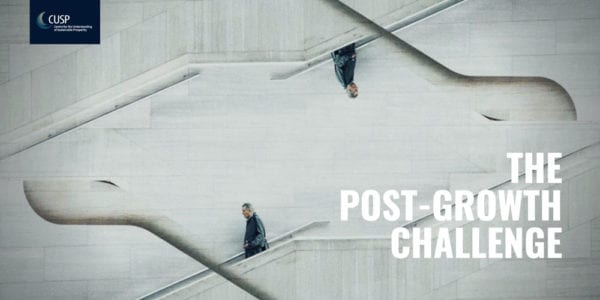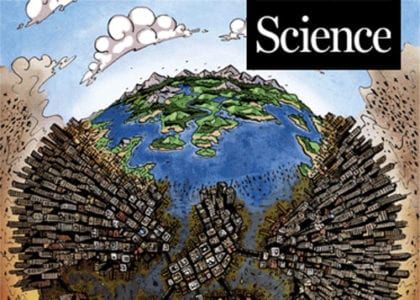The Transition to a Sustainable Prosperity—A Stock-Flow-Consistent Ecological Macroeconomic Model for Canada
Journal Paper by Tim Jackson and Peter Victor
Ecological Economics | July 2020

Summary
This paper presents a stock-flow consistent (SFC) macroeconomic simulation model for Canada. We use the model to generate three very different stories about the future of the Canadian economy, covering the half century from 2017 to 2067: a Base Case Scenario in which current trends and relationships are projected into the future, a Carbon Reduction Scenario in which measures are introduced specifically designed to reduce Canada’s carbon emissions, and a Sustainable Prosperity Scenario which incorporates additional measures to improve environmental, social and financial conditions across society. The performance of the economy is tracked using two composite indicators constructed especially for this study: an environmental burden index (EBI) which describes the environmental performance of the model; and a composite sustainable prosperity index (SPI) which is based on a weighted average of seven economic, social and environmental performance indicators.
Contrary to the widely accepted view, the results suggest that ‘green growth’ (in the Carbon Reduction Scenario) may be slower than ‘brown growth’. More importantly, we show (in the Sustainable Prosperity Scenario) that improved environmental and social outcomes are possible even as the growth rate declines to zero.
1. Introduction
The defining feature of ecological economics is its rigorous attention to the question of ecological scale (Daly and Morgan, 2019). For this reason, perhaps, it has often found itself at worst ignored and at best in outright conflict with conventional economic narratives framed around the assumption of ‘eternal’ economic growth (Liebreich, 2018). The former British prime minister, Margaret Thatcher, once famously declared that ‘there is no alternative’ to growth. Her Tory predecessor in that role, Ted Heath, insisted a decade earlier that ‘the alternative to expansion is not, as some occasionally seem to suppose, an England of quiet market towns linked only by steam trains puffing slowly and peacefully through green meadows. The alternative is slums, dangerous roads, old factories, cramped schools, stunted lives.’ (ConservativeHome, 2006, Douthwaite, 1992, 20).
The assumption that the only alternative to economic growth is social collapse still occupies such a pernicious hold over economics, politics and public attention that, even today, almost five decades after its publication, the Club of Rome’s most influential report (Meadows et al., 1972) on the limits to growth still sustains an extraordinary level of attack or outright denial. Mainstream economists, business leaders and media commentators still prefer to ‘debunk the limits to growth’ than to face up to the possibility that economies may not be able to expand forever (WEF, 2020).
In recent years, this position has become increasingly untenable, particularly in the face of accelerating climate change (Lenton et al., 2019; IPCC, 2018) and unprecedented biodiversity loss (IPBES, 2019). It has also come under particular scrutiny since the 2008 financial crisis, partly as a result of persistent social inequalities (Piketty, 2014) and partly because the rate of growth, particularly amongst the most advanced economies appears to have been in decline for several decades (Jackson, 2019a; Victor, 2019).
In this context, it is pertinent to explore the extent to which it may—despite the commonly held view—be possible to manage—and perhaps even prosper—without growth (Jackson, 2017; Lange, 2018; Victor, 2019). The concept of ‘degrowth’ was first coined by the philosopher Gorz (1972) in the 1970s and elaborated extensively by French sociologist Serge Latouche (2007) three decades later. In the years since the financial crisis it has emerged as an articulate and energetic social movement (D’Alisa et al., 2014; Kallis, 2017) sometimes spilling over into an outright rejection of economics as a discipline and an argument that economic models are little better than convenient fiction (Zhengelis, 2017; Reed, 2018).
There is a sense of course in which economic models—like all models and most theories—are indeed fiction (Shiller, 2019; Jackson, 2019b). Models are quintessentially tools for questioning our narratives about the world and developing stories about the future (Jackson, 2019c). Clearly such tools should be used with care. But rejecting their use altogether is just as likely to lead to unproductive dialogue as the uncritical use of them.
There are signs that this polarization of attitudes towards economic modelling is beginning to change. Hardt and O’Neill (2017) list twenty-two ecological macroeconomic models, including some that are empirical. Since that time, several further models have been developed (D’Alessandro et al., 2020, Dafermos et al., 2017 eg). Ecological economists have used such models to determine whether important social and environmental objectives can be achieved in a modern economy without necessarily relying on continued economic expansion, defined conventionally as an increase in real GDP. In particular, such models are useful in terms of interrogating the potential to achieve stable, low-growth economies capable of maintaining high employment while meeting stringent environmental targets and reducing income inequality.
This paper describes such a model for Canada. We use the model (LowGrow SFC) both to examine the evolution of the Canadian economy under conventional assumptions about demand, supply and the behaviour of economic actors and also to explore the potential for a transition to a sustainable prosperity—a prosperity that is inclusive, lasting and consistent with the limits of a finite planet. We are particularly interested in the macroeconomic implications of the green investments needed to achieve specific environmental goals and to remain within ‘planetary boundaries’ (Steffen et al., 2015). Specifically, we want to explore the economic, social and environmental implications of the transition to a low- or net-zero‑carbon economy (IPCC, 2018; CCC, 2019).
. . .
The article is available for download (currently in open access format) via the Science Direct website. If you have difficulties accessing the paper, please get in touch: info@cusp.ac.uk.
Citation
Jackson, T and P Victor 2020. The Transition to a Sustainable Prosperity-A Stock-Flow-Consistent Ecological Macroeconomic Model for Canada. Ecological Economics, Vol 177.






